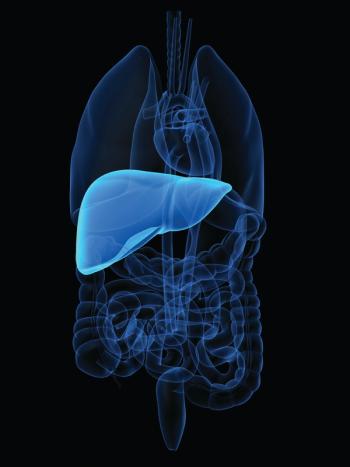
Oncology NEWS International
- Oncology NEWS International Vol 6 No 5
- Volume 6
- Issue 5
Survival Advantage Seen for HNPCC Colorectal Cancer
Hereditary nonpolyposis colorectal cancer (HNPCC) is a dominantly inherited syndrome that is estimated to be responsible for between 0.5% to 5% of all colorectal cancers.[1] The syndrome is caused by germline mutations in any of at least four mismatch repair genes.
Hereditary nonpolyposis colorectal cancer (HNPCC) is a dominantly inheritedsyndrome that is estimated to be responsible for between 0.5% to 5% ofall colorectal cancers.[1] The syndrome is caused by germline mutationsin any of at least four mismatch repair genes.
In one study of HNPCC, mutations in the MSH2 gene were found in 44%of the affected families, MLH1 gene mutations in 23% of families, and PMS1and PMS2 gene mutations in 6% of families.[2] In 27% of the affected families,mutations could not be ascertained. [See Oncology News International, April1997, for a review of HNPCC genetics.]
In carriers of the mutated genes, colo-rectal carcinoma develops typicallybefore the age of 50. The tumors appear in the proximal colon more oftenthan in patients with sporadic colon cancer. The lifetime risk of cancerin carriers is close to 100%.[3]
Since the 1970s, there have been reports of a possible survival advantagefor colorectal cancer in HNPCC patients.[4-6] In 1981, Henry T. Lynch andcolleagues hypothesized "that the genotype in hereditary cancer determinesboth susceptibility and natural history, such that increased survival isa manifestation of the natural history."[5]
A recent study from Finland provides strong evidence in favor of thishypothesis.[7] The study included 175 patients with colorectal carcinomafrom 39 families fulfilling the Amsterdam criteria of HNPCC.[8] Of thesepatients, 120 came from 22 families with three different germline mutationsin the MLH1 gene.
The patients were those diagnosed before the age of 65. Older patientswere excluded because of the possibility that they could be sporadic casesamong family members not carrying the germline mutation.
The patients were diagnosed between 1953 and 1993. The cancer diagnoseswere ascertained from the files of the nationwide, population-based FinnishCancer Registry. All the rest of the 14,261 colorectal cancer patientsdiagnosed in Finland in the same age group and calendar years were usedas controls.
Utilizing Finland's Central Population Register, the patients were followeduntil death, emigration, or the common closing date of the study, December31, 1993, whichever came first. Since everyone in Finland has a uniquepersonal identification number, none of the patients were lost to follow-up.
Avoiding Potential Biases
To avoid confounding by competing causes of death, cumulative relativesurvival rates were calculated by dividing observed rates by expected rates.The expected rates were derived from sex, age, and calendar-period-specificlife tables of the general Finnish population.
All available prognostic factors, ie, disease stage, primary site, ageand sex of the patient, and calendar year, were simultaneously adjustedfor by calculating relative excess risk of death using a life table proportionalhazards model based on annual relative survival rates for the first fivefollow-up years.
Using these methods, most of the potential biases present in previousstudies could be avoided. The HNPCC patients were collected retrospectivelyfrom the whole country as they had entered the health care system. In the1950s through 1970s, HNPCC was not recognized in clinical practice, andthus there was no detection bias. Even in the 1980s through 1993, the proportionof HNPCC patients from all colorectal cancer patients did not increase.
Since the follow-up was complete, all deaths, as well as healthy person-years,were taken into account for both HNPCC and sporadic colon cancer patients.
The expected survival rates were based on the same homogeneous Finnishpopulation from which the patients came. Finally, for the majority of patients,the HNPCC diagnosis was made on a molecular basis at the family level sothat results were much more reliable than if diagnosis had been based onthe Amsterdam criteria alone.
The cumulative relative survival rates were uniformly better for theHNPCC patients in all strata that were analyzed. The five-year relativesurvival rate was 65% for all HNPCC patients, compared with 44% for allcontrol colorectal cancer patients.
For the 120 patients from families with germline MLH1 mutations, therelative survival rate was better than for the 55 purported HNPCC patientswith no data on germline mutations who were identified using the Amsterdamcriteria alone.
The relative survival rates among patients with localized tumors were85% and 68%, respectively, for HNPCC and sporadic patients. The correspondingfigures among patients with nonlocalized tumors were 40% and 18%, respectively.
The relative survival rates were better among HNPCC patients than amongcontrols in age groups 0 to 44 years and 45 to 64 years, in men and women,in patients with tumors of the colon and the rectum, and in all four calendarperiods.
Several Hypotheses
Recent advances in molecular genetics have revealed many details ofthe underlying mechanisms and pathways involved in HNPCC (for a review,see references 1 and 2). However, the reasons for the evident survivaladvantage remain obscure. Several interesting hypothesis have been putforward.
Despite aggressive histologic tumor features in HNPCC patients,[9] thecarcinomas are diploid predominant, indicating better survival.[10,11]The numerous mutations occurring in the tumor cells might trigger the hostimmune system defenses.[12] Rhyu discusses the possibility that due tothe multitude of mutations, the loss of vital functions would drive thetumor cells toward premature death rather than immortality.[2]
Additional DNA repair mechanisms might also be involved.[1] One suchalternative could be the p53-related apoptosis pathway.[13]
Until further research provides more detailed understanding of the complexmechanisms and pathways in the tumorigenesis and natural history of HNPCCtumors, the original hypothesis by Lynch from 15 years ago is still valid.[5,14]The same genetic defect that is responsible for tumor initiation and progressionmay also reduce the viability of cancer cells.[7]
At the moment, there are no reliable clinical indicators of good prognosisin HNPCC-related colorectal carcinomas. Thus, clinical screening and treatmentprotocols must be based on the strictest criterion: To improve the survivalrates of all patients.
References:
1. Marra G, Boland CR: Hereditary nonpolyposis colorectal cancer: Thesyndrome, the genes, and historical perspective. J Natl Cancer Inst 87:1114-1125,1995.
2. Rhyu MS: Molecular mechanisms underlying hereditary nonpolyposiscolorectal carcinoma. J Natl Cancer Inst 88:240-251, 1996.
3. Lynch HT, Smyrk TC, Watson P, et al: Genetics, natural history, tumorspectrum, and pathology of hereditary nonpolyposis colorectal cancer: Anupdated review. Gastroenterology 104:1535-1549, 1993.
4. Lynch HT, Bardawil WA, Harris RF, et al: Multiple primary cancersand prolonged survival: Familial colonic and endometrial cancers. Dis ColonRectum 21:165-168, 1978.
5. Lynch HT, Albano W, Recerbaren J, et al: Prolonged survival as acomponent of hereditary breast and nonpolyposis colon cancer. Medical Hypotheses7:1201-1209, 1981.
6. Albano WA, Recabaren J, Lynch HT, et al: Natural history of hereditarycancer of the breast and colon. Cancer 50:360-363, 1982.
7. Sankila R, Aaltonen LA, Jarvinen HJ, et al: Better survival ratesin patients with MLH1-associated hereditary colorectal cancer. Gastroenterology110:682-687, 1996.
8. Vasen HFA, Mecklin J-P, Meera Khan P, et al: The International CollaborativeGroup on Hereditary Non-Polyposis Colorectal Cancer (ICG-HNPCC). Dis ColonRectum 34:424-425, 1991.
9. Jass JR, Smyrk TC, Stewart SM, et al: Pathology of hereditary non-polyposiscolorectal cancer. Anticancer Res 14:1631-1634, 1994.
10. Kouri M, Laasonen A, Mecklin J-P, et al: Diploid predominance inhereditary nonpolyposis colorectal carcinoma evaluated by flow cytometry.Cancer 65:1825-1829, 1990.
11. Frei TV: Hereditary nonpolyposis colorectal cancer (Lynch syndromeII): Diploid malignancies with prolonged survival. Cancer 69:1108-1111,1992.
12. Bodmer W, Bishop T, Karran P: Genetic steps in colorectal cancer.Nat Genet 6:217-219, 1994.
13. Oren M: Relationship of p53 to the control of apoptotic cell death.Semin Cancer Biol 5:221-227, 1994.
14. Lynch HT, Smyrk T: Colorectal cancer, survival advantage, and hereditarynonpolyposis colorectal cancer. Editorial. Gastroenterology 110:943-947,1996.
Articles in this issue
over 28 years ago
Delaying Chemotherapy May Compromise Distant Controlover 28 years ago
Precision Dosing a Reality with Intensity Modulated RTover 28 years ago
Breast Cancer Guide on CD-ROM Is Availableover 28 years ago
Mammography's Predictive Value May Be Improvedover 28 years ago
Oncology Administrators Must Plan for Transition in Mergersover 28 years ago
Differentiation Agent Improves Myelodysplasia Survival Ratesover 28 years ago
NCPB Hears From Several Cancer Groups on Policy Issuesover 28 years ago
Guidelines Needed for Distress in Cancer Patientsover 28 years ago
Skin Cancer Project Receives Recognitionover 28 years ago
Few Patients Surveyed Regret Prophylactic MastectomyNewsletter
Stay up to date on recent advances in the multidisciplinary approach to cancer.



















































































